Spartacus Blog
Art and Politics: The Work of John Heartfield
Wednesday, 18th November, 2015

On 1st May, 1916, Helmut Herzfeld attended a public meeting organised by the Spartacus League against the First World War in Berlin. The two main speakers, Karl Liebknecht and Rosa Luxemburg, called for everyone to resist Germany's involvement in the war. After the meeting, Liebknecht and Luxemburg were arrested and imprisoned (they were both murdered by right-wing nationalists soon after the war ended.
Helmut's brother, Wieland Herzfeld, later recalled that the speeches at the rally had a great influence on him. It was at this point he decided to dedicate his art to politics. Wieland later wrote: "We are the soldiers of peace. No nation and no race is our enemy." (1) Herzfeld, became a pacifist and changed his name to John Heartfield in 1916 in "protest against German nationalistic fervour". (2)
John Heartfield began contributing work to Die Neue Jugend, an arts journal published by his brother. His friend, George Grosz, who worked with him at the journal, later recalled how John Heartfield "developed a new very amusing style of using collage and bold typography". (3) Grosz helped him develop what became known as photomontage (the production of pictures by rearranging selected details of photographs to form a new and convincing unity). We... invented photomontage in my South End studio at five o'clock on a May morning in 1916, neither of us had any inkling of its great possibilities, nor of the thorny yet successful road it was to take. As so often happens in life, we had stumbled across a vein of gold without knowing it." (4)
Bertolt Brecht first met Heartfield in 1924. He pointed out that he soon became one of the most important European artists. "He works in a field that he created himself, the field of photomontage. Through this new form of art he exercises social criticism. Steadfastly on the side of the working class, he unmasked the forces of the Weimar Republic driving toward war." (5) Heartfield wrote: "Art and agitation are mutually exclusive". (6) Wieland Herzfelde argued "he consciously placed photography in the service of political agitation". (7)
Heiri Strub has pointed out that Heartfield made the decision to use his art for political causes. "Heartfield always considered his photomontages as artistic achievements. He took in stride the fact that he was not recognized by contemporary art critics. The works he created for dissemination in huge editions had no value in the art market. Directing his political charges at the masses, he could scarcely count on a sympathetic reaction from bourgeois art collectors. The worker, however, for whom he intended his photomontages, understood their revolutionary content, but assigned no artistic value judgment to them." (8)
Heartfield began working for the socialist magazine, Arbeiter-Illustrierte-Zeitung (AIG) in 1929. During this period it became the most widely socialist pictorial newspaper in Germany. Circulation reached 350,000 in 1930. (9) Zbynek Zeman has pointed out that at this stage Heartfield concentrated his attack on "Prussian militarism and the large-scale industries and industrialists who supplied it with arms". (10)
The German novelist, Heinrich Mann, was one of those who saw the significance of the magazine: "The Arbeiter-Illustrierte-Zeitung is one of the best of current picture newspapers. It is full in its coverage, technically good, and, above all, unusual and new... Aspects of daily life are seen here through the eyes of the worker, and it is time that this happened. The pictures express complaints and threats reflecting the attitude of the proletariat - but at the same time this proves their self-confidence and their energetic activity to help themselves. The self-confidence of the proletariat in this weary part of the world is most heartening." (11)
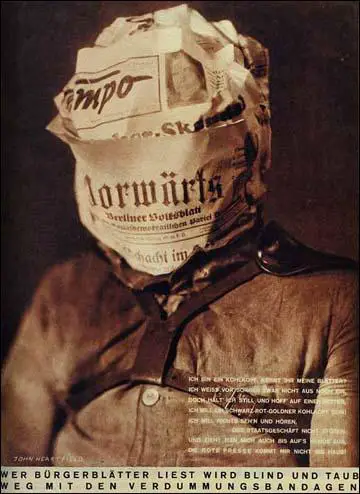
become blind and deaf, Arbeiter-Illustrierte-Zeitung (AIG) (February 1930)
(Copyright The Official John Heartfield Exhibition & Archive)
John Heartfield's main target in the early 1930s was Adolf Hitler and his Nazi Party. His work often appeared on the front cover of AIG. In 1930 the magazine published twelve of his photomontages. This included one that showed Fritz Thyssen, the owner of United Steelworks, a company that controlled more that 75 per cent of Germany's ore reserves and employed 200,000 people. In the photomontage, Thyssen is shown working Hitler as a puppet.
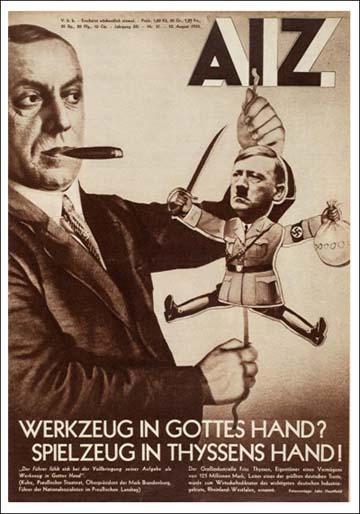
(Copyright The Official John Heartfield Exhibition & Archive)
In the election in November 1932 the Nazi Party won 230 seats, making it the largest party in the Reichstag. The German National Party, won nearly a million additional votes. However the German Social Democrat Party (133) and the German Communist Party (89) still had the support of the urban working class and Hitler was deprived of an overall majority in parliament. In numerical terms, the socialist parties obtained 13,228,000 votes compared to the 14,696,000 votes recorded for the Nazis and the German Nationalists. (14)
Soon after Hitler became chancellor in January 1933 he announced new elections. Hermann Goering called a meeting of important industrialists where he told them that the election would be the last in Germany for a very long time. He explained that Hitler "disapproved of trade unions and workers' interference in the freedom of owners and managers to run their concerns." (15) Goering added that the NSDAP would need a considerable amount of of money to ensure victory. Those present responded by donating 3 million Reichmarks. As Joseph Goebbels wrote in his diary after the meeting: "Radio and press are at our disposal. Even money is not lacking this time." (16)
On 27th February, 1933, the Reichstag caught fire. When they police arrived they found Marinus van der Lubbe on the premises. After being tortured by the Gestapo he confessed to starting the Reichstag Fire. However he denied that he was part of a Communist conspiracy. Hermann Goering refused to believe him and he ordered the arrest of several leaders of the German Communist Party (KPD).
When Hitler heard the news about the fire he gave orders that all leaders of the German Communist Party should "be hanged that very night." Paul von Hindenburg vetoed this decision but did agree that Hitler should take "dictatorial powers". KPD candidates in the election were arrested and Hermann Goering announced that the Nazi Party planned "to exterminate" German communists. John Heartfield responded to these events by producing Goering the Executioner of the Third Reich. It shows the "human bloodhound with his axe standing in front of the burning parliament." (17)
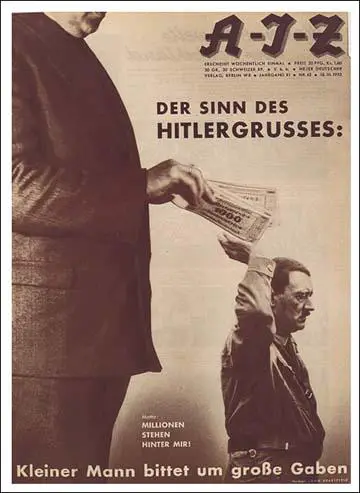
(Copyright The Official John Heartfield Exhibition & Archive)
Thousands of members of the Social Democrat Party and trade union activists were arrested and sent to recently opened concentration camps. Left-wing election meetings were broken up by the Sturm Abteilung (SA) and several candidates were murdered. Newspapers that supported these political parties were closed down during the election. Although it was extremely difficult for the opposition parties to campaign properly, Hitler and the Nazi party still failed to win an overall victory in the election on 5th March, 1933. The Nazi Party received 43.9% of the vote and only 288 seats out of the available 647. The increase in the Nazi vote had mainly come from the Catholic rural areas who feared the possibility of an atheistic Communist government.
Adolf Hitler ordered the arrests of all those artists that had criticized him during his rise to power. (19) On 16th April, 1933, members of the Sturmabteilung (SA) arrived at Heartfield's apartment. Heartfield had been warned about what was going to happen and he managed to flee to Prague. This now became the place where AIG was published. That year Heartfield produced 35 front-covers. However, it was very difficult to smuggle the magazine back to Germany and circulation dropped dramatically from the 500,000 copies that were being sold before Hitler took power. (20)
All forms of mass communication were now controlled in Nazi Germany. The man in overall charge was Dr. Joseph Goebbels, the Minister of Propaganda. Lists were drawn up of books the Nazis believed contained "un-German" ideas and then all available copies were publically destroyed. The Nazis were especially hostile to works produced by left-wing writers like Bertolt Brecht and Ernst Toller.
John Heartfield was especially upset by the passing of the Enabling Bill. This banned the German Communist Party and the Social Democratic Party from taking part in future election campaigns. This was followed by Nazi officials being put in charge of all local government in the provinces (7th April), trades unions being abolished, their funds taken and their leaders put in prison (2nd May), and a law passed making the Nazi Party the only legal political party in Germany (14th July). This situation motivated Heartfield to produce the Executioner and Justice on 30th November 1933.
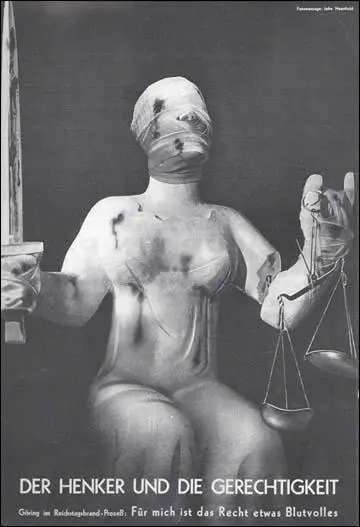
(Copyright The Official John Heartfield Exhibition & Archive)
Adolf Hitler became increasingly annoyed with John Heartfield's photomontages published in Prague (35 in 1933) and he told the government in Czechoslovakia to ban his work. In May 1934 the authorities agreed to Hitler's demands. This created a great deal of controversy and the French artist, Paul Signac, urged international action. He wrote a letter to Heartfield's supporters in Prague: "My whole life long I have been fighting for the freedom of art... I am prepared to contribute my share in organizing a French exhibition of our friend's works... The club is poised for battle against the freedom of the spirit. Let us unite to defend ourselves." (21)
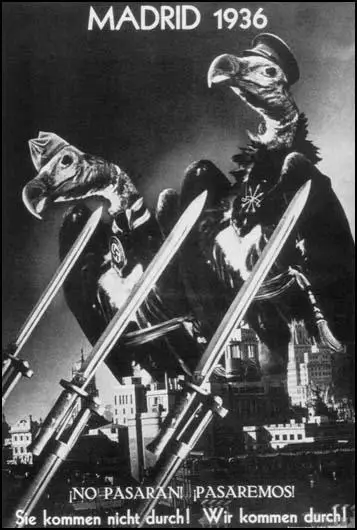
(Copyright The Official John Heartfield Exhibition & Archive)
Heartfield's friends in Europe helped to get his work published. Several photomontages on the Spanish Civil War were published. This included Madrid 1936, a work of art that dealt with the Siege of Madrid. Another poster, The Mothers to their Sons in Franco's Service, was published in December 1936. On the poster it said: "For what you were hired. Whom you are hounding. So permit us mothers to tell you: We grieve for you, young ones. No, we did not raise you to murder. You are allowing yourselves to be abused. You have been betrayed!" (22)
In October 1937 John Heartfield published Warning. In the photomontage an audience looks at a scene of horror caused by Japanese air raids in Manchuria. "Heartfield's pastiche layers in several rows of faceless male heads, backs towards us, beneath the frontal stare of an on-screen victim in the violent newsreel footage at which they are staring: a Chinese mother holding a bloodied child in outsized close-up." (23) It had the caption: "Today you see a film of war in other countries. But remember, if you don't unite to resist it now, tomorrow it will kill you, too!" It was a prediction that was to come true within two years.
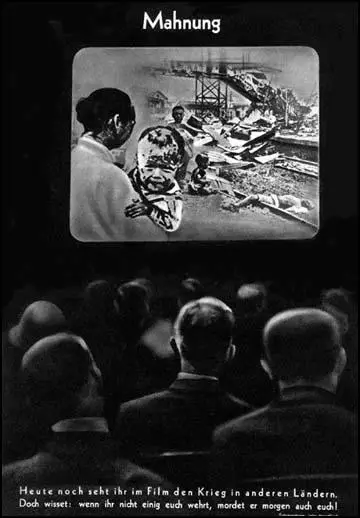
(Copyright The Official John Heartfield Exhibition & Archive)
When Adolf Hitler ordered the invasion of Czechoslovakia after the Munich Agreement of 1938 John Heartfield was forced to flee the country. In December he arrived in London. Over the next few months his work appeared in the Reynolds News and Lilliput. He spoke at political rallies, organized anti-Fascist groups, and took part in a successful political cabaret, Four and Twenty Black Sheep. On 23rd September, 1939, Picture Post used one of Heartfield's earlier photomontages, His Majesty Adolf, which showed Hitler wearing the Kaiser's uniform and moustache, on its front-cover. (24)
On the outbreak of the Second World War he was interned with fellow refugees who had suffered under the Nazis and were now dubbed "enemy aliens". He was suffering from poor health and he was eventually released but he was not asked to work for the British government. "His whole ambition was to make people fully aware of the menace of Fascism and to expose the Nazi tyranny through his work as an artist... The powerful contribution he might have made toward the Allied victory through his mastery of satire was not acceptable to the British authorities. They were highly suspicious of art, especially experimental forms of art by a German refugee." (25)
One of John Heartfield most powerful photomontages, This is the Salvation that they Bring!, that had originally been published in protest against the Spanish Civil War , was republished during the Blitz . On the poster it had an extract from an article that appeared in the Nazi Party funded Berlin Journal for Biology and Race Research: "The densely populated sections of cities suffer most acutely in air raids. Since these areas are inhabited for the most part by the ragged proletariat, society will thus be rid of these elements. One-ton bombs not only cause death but also very frequently produce madness. People with weak nerves cannot stand such shocks. That makes it possible for us to find out who the neurotics are. Then the only thing that remains is to sterilize such people. Thereby the purity of the race is guaranteed." (26)
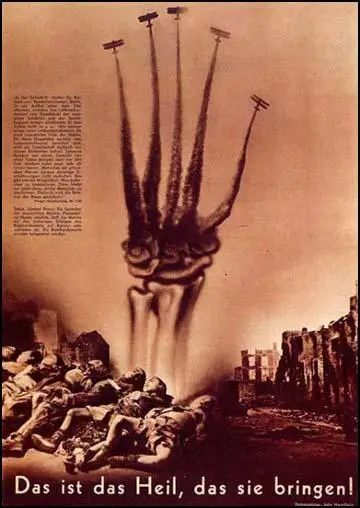
(Copyright The Official John Heartfield Exhibition & Archive)
John and his third wife, Gertrud (Tutti) Heartfield, settled in Hampstead. During the war he was an active member of the Artists International Association and contributed to its exhibitions. Heartfield also designed book jackets for the London publisher Lindsay Drummond and Penguin Books. (27)
John Heartfield and his wife moved to Leipzig in East Germany in August 1950. Together with his brother, Wieland Herzfelde, he worked for publishers and organizations in the GDR. He also designed scenery and posters for the Berliner Ensemble and the Deutsches Theatre. However, as Peter Selz has pointed out, he found it difficult to produce political photomontages. "While he was celebrated as a cultural leader, his chief idiom, photomontage, was still suspect during the 1950s among the more orthodox advocates of socialist realism." (28)
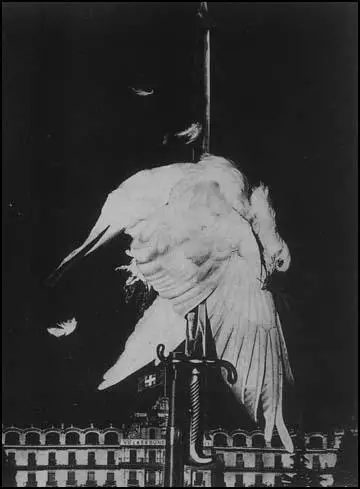
(Copyright The Official John Heartfield Exhibition & Archive)
Heartfield continued to be a peace activist and on 9th June 1967, at the time of an exhibition of his works at the Stockholm Modern Museum, he wrote about the dangers posed by the Vietnam War. "Since we are living in the nuclear age, a third world war would mean a catastrophe for all mankind, a catastrophe the full extent of which cannot be possibly be imagined.... The war of extermination against the Vietnamese people, fighting heroically for their existence... Now there is a war in the Middle East! Shortly before that, a monarchist-fascist putsch smothered every democratic political movement in Greece. The flames are licking at your doorstep! Today peace-loving men of all nations must work together even more closely; must mobilize all the resources to strengthen and preserve world peace, since powerful rulers again lust for war." John Heartfield died in Berlin on 26th April, 1968.
Previous Posts
Does going to war help the careers of politicians? (2nd December, 2015)
Art and Politics: The Work of John Heartfield (18th November, 2015)
The People we should be remembering on Remembrance Sunday (7th November, 2015)
Why Suffragette is a reactionary movie (21st October, 2015)
Volkswagen and Nazi Germany (1st October, 2015)
David Cameron's Trade Union Act and fascism in Europe (23rd September, 2015)
The problems of appearing in a BBC documentary (17th September, 2015)
Mary Tudor, the first Queen of England (12th September, 2015)
Jeremy Corbyn, the new Harold Wilson? (5th September, 2015)
Anne Boleyn in the history classroom (29th August, 2015)
Why the BBC and the Daily Mail ran a false story on anti-fascist campaigner, Cedric Belfrage (22nd August, 2015)
Women and Politics during the Reign of Henry VIII (14th July, 2015)
The Politics of Austerity (16th June, 2015)
Was Henry FitzRoy, the illegitimate son of Henry VIII, murdered? (31st May, 2015)
The long history of the Daily Mail campaigning against the interests of working people (7th May, 2015)
Nigel Farage would have been hung, drawn and quartered if he lived during the reign of Henry VIII (5th May, 2015)
Was social mobility greater under Henry VIII than it is under David Cameron? (29th April, 2015)
Why it is important to study the life and death of Margaret Cheyney in the history classroom (15th April, 2015)
Is Sir Thomas More one of the 10 worst Britons in History? (6th March, 2015)
Was Henry VIII as bad as Adolf Hitler and Joseph Stalin? (12th February, 2015)
The History of Freedom of Speech (13th January, 2015)
The Christmas Truce Football Game in 1914 (24th December, 2014)
The Anglocentric and Sexist misrepresentation of historical facts in The Imitation Game (2nd December, 2014)
The Secret Files of James Jesus Angleton (12th November, 2014)
Ben Bradlee and the Death of Mary Pinchot Meyer (29th October, 2014)
Yuri Nosenko and the Warren Report (15th October, 2014)
The KGB and Martin Luther King (2nd October, 2014)
The Death of Tomás Harris (24th September, 2014)
Simulations in the Classroom (1st September, 2014)
The KGB and the JFK Assassination (21st August, 2014)
West Ham United and the First World War (4th August, 2014)
The First World War and the War Propaganda Bureau (28th July, 2014)
Interpretations in History (8th July, 2014)
Alger Hiss was not framed by the FBI (17th June, 2014)
Google, Bing and Operation Mockingbird: Part 2 (14th June, 2014)
Google, Bing and Operation Mockingbird: The CIA and Search-Engine Results (10th June, 2014)
The Student as Teacher (7th June, 2014)
Is Wikipedia under the control of political extremists? (23rd May, 2014)
Why MI5 did not want you to know about Ernest Holloway Oldham (6th May, 2014)
The Strange Death of Lev Sedov (16th April, 2014)
Why we will never discover who killed John F. Kennedy (27th March, 2014)
The KGB planned to groom Michael Straight to become President of the United States (20th March, 2014)
The Allied Plot to Kill Lenin (7th March, 2014)
Was Rasputin murdered by MI6? (24th February 2014)
Winston Churchill and Chemical Weapons (11th February, 2014)
Pete Seeger and the Media (1st February 2014)
Should history teachers use Blackadder in the classroom? (15th January 2014)
Why did the intelligence services murder Dr. Stephen Ward? (8th January 2014)
Solomon Northup and 12 Years a Slave (4th January 2014)
The Angel of Auschwitz (6th December 2013)
The Death of John F. Kennedy (23rd November 2013)
Adolf Hitler and Women (22nd November 2013)
New Evidence in the Geli Raubal Case (10th November 2013)
Murder Cases in the Classroom (6th November 2013)
Major Truman Smith and the Funding of Adolf Hitler (4th November 2013)
Unity Mitford and Adolf Hitler (30th October 2013)
Claud Cockburn and his fight against Appeasement (26th October 2013)
The Strange Case of William Wiseman (21st October 2013)
Robert Vansittart's Spy Network (17th October 2013)
British Newspaper Reporting of Appeasement and Nazi Germany (14th October 2013)
Paul Dacre, The Daily Mail and Fascism (12th October 2013)
Wallis Simpson and Nazi Germany (11th October 2013)
The Activities of MI5 (9th October 2013)
The Right Club and the Second World War (6th October 2013)
What did Paul Dacre's father do in the war? (4th October 2013)
Ralph Miliband and Lord Rothermere (2nd October 2013)
